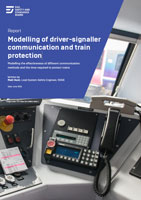Driver-signaller communication and train protection modelling
Usually, drivers and signallers communicate over the GSM-R network using the train cab radio. Sometimes the GSM-R network or train cab radio cannot be used. There are alternatives but these needed to be assessed.
There had already been a modelling report about the failure of GSM-R. Some recent changes showed the need for a new modelling of driver-signaller communication and train protection.
What changes make new modelling necessary?
These changes are:
-
Feedback from the revision of GOGN3677 Guidance Note on the Provision of Lineside Telephones
There was a five-year review of GOGN3677 issue one Guidance Note on the Provision of Lineside Telephones. This included consultation with stakeholders. Their feedback showed concerns about inconsistencies in providing secondary communications systems when GSM-R radio cannot be used.
There were concerns about this across rail.
-
Withdrawal of the Fixed Lineside Telephony Assessment Tool
The Fixed Lineside Telephony Assessment Tool (FLAT) gave an evidence base for lineside telephones in some areas. However, it became outdated. It was therefore withdrawn.
The withdrawal of FLAT makes it difficult to assess the risks of using lineside telephones. A new method for assessing these risks was needed.
-
Findings from project T1155 Reviewing the risks and benefits of detonator usage
Previous research about using detonators found that the risk to staff when laying assistance protection can sometimes be greater than the risk of the assisting train travelling too far and having a collision.
We needed to know whether this also applied to the placement of emergency protection. This would also show whether detonator use could be reduced, and by how much.
What are the results of the driver-signaller communication modelling?
The modelling about communication and protection explored the alternatives to GSM-R. It found:
- the best actions to take for drivers and signallers to communicate or protect trains
- the best order of actions for drivers and signallers to communicate or protect trains
- the best way to use detonators, hand signals, and track circuit operating clips for emergency protection.


